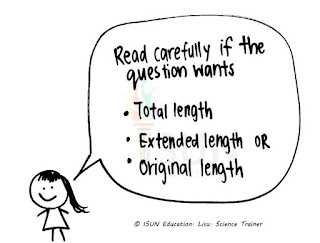3 COMMON MISTAKES IN FORCES:
*Apologies that the alignment of this page is off & I can't seem to get it adjusted for now. If you want a downloadable worksheet, PM us at isuninfo@gmail.com*1. Gravitational force (GF) vs Gravitational Potential Energy (GPE)
Example 1
The ISUN warriors were playing at the corridor with a wooden
ball. Xavier accidentally threw a ball and it travelled in the path as shown
below rolling to a stop.
Which one of the following statements is correct?
1)
Gravity acted on the ball only when it travelled
from Q to R.
2)
There are no other forces acting on the ball
from P to Q except gravity.
3)
The amount gravity acting on the ball when it
travelled from P to R is the same.
4)
The amount of gravity acting on the ball
increased when the ball travelled from P to Q and decreased when it dropped
from Q to R.
Common Answer: 4
Why is it wrong?
Students often confused gravitational potential energy (GPE) with
gravitation force (GF).
Option 4 is correct if we changed it to: “The amount of GRAVITATIONAL POTENTIAL ENERGY
acting on the ball increased when the ball travelled from P to Q and
decreased when it dropped from Q to R”
Actual Answer: 3
Use the strategy: GF
= weight. Now, re-read option 3: “The[amount gravity acting on] (WEIGHT of) the ball when
it travelled from P to R is the same.”
|
Example 2
The diagram below shows the path of a football after Caeden
had kicked it.
Which one of the follow graphs shows the relationship
between the height of the ball above the ground and its gravitational force
acting on it?
Common Answer: 1
Why is it wrong?
Grapph 1 is for GPE
Actual Answer: 2
Use the strategy: GF
= weight. The[amount gravity acting on] (WEIGHT of) the ball at any point is the same.
|
Apply the strategy that I just taught you: “GF = Weight”
Example 3
Max and Woon Seng went for an
adventure camp. The diagram below shows the 2 boys, A and B as they slide down
the zipline from 2 different heights.

Which one of the following
statements best describes the gravitational force possessed by the 2 boy of
similar built and at similar starting point but different height?
1)
Both boys have no gravitational force acting on
them
2)
Boy A has less gravitational force acting on him
than Boy B
3)
Boy A has more gravitational force acting on him
than Boy B
4)
Both boys have similar amount of gravitational
force acting on them
Did you get it? The answer is 4!
The boys have similar built
thus their weight is the similar and thus similar gravitational force is
acting on it.
|
2. Frictional Force

Example
Block M is a bar magnet. It was placed on a flat glass table
as shown below. A copper block was attached to the bottom of the table. Block M
was given a push to move along the table.
(a)
Which of the force(s) below must the push
overcome in order for Block M to move along the table?
1)
Frictional only
2)
Frictional and Magnetic only
3)
Frictional and Gravitational only
4)
Frictional, Gravitational and Magnetic
Common mistake: 3
Actual answer: 1
Students know that there are frictional and gravitational force
acting on the object but they didn’t relate to what the question wants. The
push force needs to overcome frictional force between the table and the block
M to move across the table from left to right (FF is acting on the block in
the opposite direction).
|
(b)
Which of the following force(s) is/are acting on
block M when it has come to a complete stop?
1)
Frictional only
2)
Gravitational only
3)
Frictional and Gravitational only
4)
Frictional, Gravitational and Magnetic
Common mistake: 3
Actual answer: 2
Recall: There is no friction acting on the object when it is
stationary.
|
(c)
Which of the following force(s) is/are acting on
block M as it move along the table?
1)
Frictional only
2)
Frictional and Magnetic only
3)
Frictional and Gravitational only
4)
Frictional, Gravitational and Magnetic
Actual answer: 3
Recall: When the object is moving, there is friction between the
block M and table top. Gravitational force acts on an object all the time.
|
(d)
Design a question using the above diagram such
that the answer is 4.
Question:
_______________________________________________________________________
________________________________________________________________________________
1) Frictional
only
2) Frictional
and Magnetic only
3) Frictional
and Gravitational only
4) Frictional,
Gravitational and Magnetic
(4)
Possible question,
If the copper block was replaced with a cobalt block, which of the
following force(s) is/are acting on block M as it move along the table?
|
3. Elastic Spring Force
Are you having the same answer as the student too?
Read again! The question is asking for final length but the
graph shows extension!
Hope that the above tips will help your child! :)
THE WAY THAT IT IS BROUGHT ACROSS TO YOUR CHILD IS IMPORTANT!
ENGAGE THEM! These questions are pasted around our place and they are to solve it as a team. They made mistakes & they learn from it.
What happens if its just delivering it on worksheet/slides to them? What difference in the impact of the learning would it make?
Should your child need an intensive program beyond just academics in this PSLE, you can check it out here!
Cheers,
Lisu
ISUN Trainer















Thanks its really useful, my next step is to find best PSLE tuition
ReplyDelete